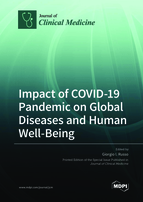Impact of COVID-19 Pandemic on Global Diseases and Human Well-Being
A special issue of Journal of Clinical Medicine (ISSN 2077-0383). This special issue belongs to the section "Nephrology & Urology".
Deadline for manuscript submissions: closed (25 November 2021) | Viewed by 41325
Special Issue Editor
Interests: prostate cancer; bladder cancer; erectile dysfunction; andrology; benign prostatic hyperplasia
Special Issues, Collections and Topics in MDPI journals
Special Issue Information
Dear Colleagues,
The wide spread of COVID-19 has had significant and negative effects on human well-being, but it has also had a negative impact on many important diseases. It has necessitated a major reorganisation of emergency care facilities to accommodate the additional workload anticipated with the rapid surge in critically ill patients with COVID-19. Previous reports have demonstrated a reduction in admissions for different conditions like acute coronary syndrome or decreased use of coronary procedures in various countries affected by the COVID-19 pandemic, leading to an increase in out-of-hospital deaths and long-term complications of myocardial infarction and missed opportunities to offer secondary prevention treatment for patients with coronary heart disease.
In this context, we do not know what impacts these events may have had in psychology and sexuality. It is well-recognized that clinical depression is associated with a reduction in sexual interest and response, an association that may be more marked in women than in men. In fact, the global pandemic of COVID-19 has significantly impacted people’s sexual desire and behaviours.
Besides these events, the daily activities of many departments have been drastically reduced and limited to non‐deferrable procedures, and the entire organogram has been reorganised following a rigorous flowchart. In order to limit the impact of the COVID‐19 emergency on residents’ learning curves, which can further affect surgical and scientific learning, new alternative teaching methods should be introduced.
In this Special Issue, we invite researchers and clinicians to submit their works, including original clinical research studies, meta-analyses, and systematic reviews, that will provide additional knowledge on the impact of the COVID-19 pandemic on global diseases and human well-being.
Prof. Giorgio I. Russo
Guest Editor
Manuscript Submission Information
Manuscripts should be submitted online at www.mdpi.com by registering and logging in to this website. Once you are registered, click here to go to the submission form. Manuscripts can be submitted until the deadline. All submissions that pass pre-check are peer-reviewed. Accepted papers will be published continuously in the journal (as soon as accepted) and will be listed together on the special issue website. Research articles, review articles as well as short communications are invited. For planned papers, a title and short abstract (about 100 words) can be sent to the Editorial Office for announcement on this website.
Submitted manuscripts should not have been published previously, nor be under consideration for publication elsewhere (except conference proceedings papers). All manuscripts are thoroughly refereed through a single-blind peer-review process. A guide for authors and other relevant information for submission of manuscripts is available on the Instructions for Authors page. Journal of Clinical Medicine is an international peer-reviewed open access semimonthly journal published by MDPI.
Please visit the Instructions for Authors page before submitting a manuscript. The Article Processing Charge (APC) for publication in this open access journal is 2600 CHF (Swiss Francs). Submitted papers should be well formatted and use good English. Authors may use MDPI's English editing service prior to publication or during author revisions.
Keywords
- COVID-19
- training
- surgery
- cancer
- oncology
- disease
- coronavirus







